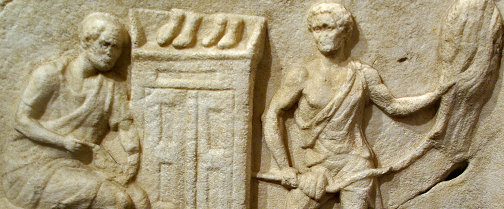
Prof. Tommaso Bertoldi
(This email address is being protected from spambots. You need JavaScript enabled to view it. - This email address is being protected from spambots. You need JavaScript enabled to view it. )
a.y. 2024/2025
Archaeology of the Roman Empire
1st semester
--------------------------------------------------------------------------------------------------
Prof. Alessio De Cristofaro (up to A.Y. 2023/2024)
(This email address is being protected from spambots. You need JavaScript enabled to view it.)
Archaeology of the Roman Empire
1st semester
The course illustrates the history of ancient Rome from the Iron Age to the Late Antique, through the analysis of the main monuments and archaeological data. Particular attention is paid to the discussion of some methodological and critical tools and themes indispensable for the study of the Roman world: excavation methods, historical-artistic analysis, philological analysis, epigraphic and numismatic study.
The exam consists of an oral test, in which the critical issues and problem discussed in the course are examined. Commenting on the images of monuments and archaeological finds, the exam will be aimed at verifying the knowledge of the data, the critical ability to organize the archaeological evidence by historical themes and problems, the development of a scientific language appropriate to the subject.
Materials
- Teacher's Lecture notes and power point
- Handbooks about roman art and roman topography
Bibliography
- B. Borg (ed), A Companion to a Roman Art, Blackwell Companions to the Ancient World
- F. Coarelli, Rome and Environs. An archaeological guide, 2007 or A. Claridge, Rome (Oxford Archaeological Guides)
Archaeology of the Roman Empire - course overview
1. Romulus' Rome. The foundation and settlement
2. Romulus' Rome. Necropolises and religious culture
3. The Great Rome of the Tarquinii. Urban planning and cults
4. The Great Rome of the Tarquinii. Religious rites and artistic culture
5. Roman art in the Middle Republican age: sanctuaries and material culture
6. Roman art in the Middle Republican age: sculpture and painting
7. The late Republican age: public and private architecture
8. The Late Republican age: Roman painting (1st and 2nd style)
9. The Late Republican age: sculpture
10. The Late Republican age: decorative arts and ceramics
11. The age of Augustus I. The city, the Ara Pacis Augustae.
12. The age of Augustus II. Portraits, painting (III style), decorative arts
13. From Tiberius to Claudius
14. The reign of Nero. The Domus Aurea
15. Flavii I: from Vespasianus to Titus. Architecture
16. Flavii II: from Vespasianus to Titus. Sculpture and painting (IV style)
17. The age of Trajan. Forum, Column and Markets of Trajan
18. The great public works: Trajan Portus, Mausoleum of Hadrian
19. Hadrian and roman neoclassicism
20. Villa Adriana and the otium
21. The Golden Age of the Antonines I: architecture
22. The Golden Age of the Antonines II: sculpture and minor arts
23. Sarcophagi
24. Art and funeral customs
25. Severan Age I: the city and the Forma Urbis
26. Severan Age II: sculpture and painting
27. The age of chaos: the Military Anarchy
28. The Late Antique: Maxentius' Rome
29. The Rome of Constantine
30. Late Antique Roman Art
-----------------------------------------------------------------------------------------

Materials & Bibliography 2018/2019 (Prof. Virginia Lapenta)
- The Roman Villa of Farnesina
- National Roman Musuem of Palazzo Massimo
- Trastevere during Augustan Age
- Roman Private Building
- Roman Decorative Elements
- Roman Forum (Foro Romano)
- Esquiline - Domus Aurea
- Via Appia - The Appian Way
